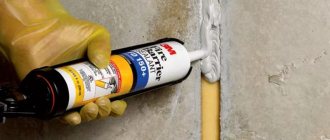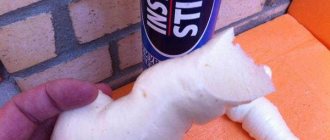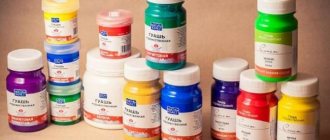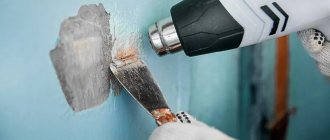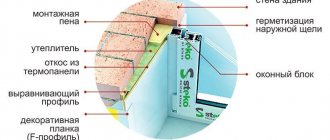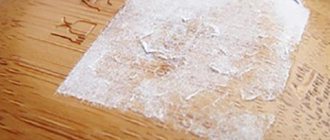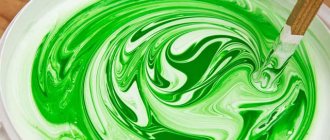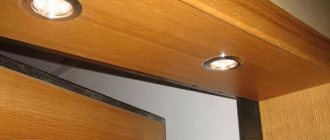Answering the question - how to clean dried polyurethane foam, it is necessary to find out its chemical composition, determine which solutions can remove such contaminants without leaving a trace. There are many special liquids that will help effectively remove hardened foam from wooden, metal, and plastic surfaces. But what to do when polyurethane foam gets on your hands, body or face? This building material consists of polyurethane foam, has a high degree of adhesion and strong adhesive properties. This is why it is so difficult to clean from various surfaces. But this needs to be done! How can you wash polyurethane foam from wooden products?
What is polyurethane foam?
Polyurethane foam is a polyurethane foam sealant that has high insulating properties and good adhesion to various materials. The porous structure of the chemical compound provides reliable protection from external noise and temperature changes. The substance is used to fill cracks, seams and inaccessible cavities.
After being forced out of the container, the liquid building material quickly hardens. The mounting medium does not respond to changes in humidity and air temperature, does not conduct electric current and does not crumble.
Polyurethane foam sealant is actively used for installing doors and windows for several reasons:
- hardens quickly;
- attaches to any type of coating;
- protects metal elements from corrosion;
- consists of environmentally friendly components;
- guarantees a long period of operation;
- does not require the use of additional tools.
The use of foam for installation is characterized by some nuances:
- for the building material to harden, access to fresh air is necessary;
- You cannot carry out insulation in the cold - the lower the air temperature, the longer the composition will harden;
- cylinders with high-quality mounting agents have a high cost;
- The sealant is not suitable for external finishing - it must be covered with facing material.
How quickly it hardens
After applying polyurethane foam to any material, it hardens. The process takes place in two stages:
- Setting - within 20 minutes from the moment of contact with the surface, the outer layer of insulation dries. At this stage, the foam looks like a pasty porous mass that gradually expands.
- Curing is the internal hardening of the sealant. Depending on the ambient temperature, moisture level and brand of installation agent, hardening lasts from 4 to 12 hours.
Before filling the cracks, it is necessary to protect the door leaf from contamination with building materials. All areas that may get foam are sealed with masking tape or film.
How to clean foam stains on a car
Cleaning the surface of a car body is a complex process. Therefore, it is better to entrust it to specialists. If you decide to deal with stains yourself, then you should give preference to more gentle methods.
Attention! You should not wash the foam with a rag without additional means, this will lead to an increase in the area of contamination.
To quickly remove fresh foam, it is recommended to use Dimexide. Unlike aggressive solvents, it will not damage the body paint.
The method of application is simple: first, the bulk of the foam is removed from the surface, leaving only a thin layer. It is better to do this with a plastic or wooden scraper so that there are no scratches or abrasions on the car enamel. After this, carefully wipe off the stain using a swab or napkin soaked in Dimexide. After treatment, rinse off the reagent with water.
Dried stains are removed with special means, however, it is worth testing in a closed area first.
There is an opinion that if the owner of the car is not bothered by the presence of dirt on the body, then it is not worth removing the foam using special methods. The fact is that polyurethane is destroyed under the influence of external factors: sunlight or low temperatures . Therefore, after a couple of weeks, the foam will self-destruct from the car enamel.
How to ensure surface protection during work
Even a professional builder cannot boast of the complete absence of unwanted lumps of foam. Therefore, if it is impossible to avoid polyurethane foam stains, it is necessary to protect all surfaces from them. Repair experts recommend following three rules.
- Work clothes. Be sure to pick up things that you will throw away with a light heart after renovation. It is very difficult to wash construction foam from clothes. Remember that most often your hands and hair suffer from working with foam. Therefore, be sure to wear rubber gloves and do not take them off under any circumstances. Pull a hat over your head or tie a scarf, completely hiding your curls under the headdress. Neglecting the rule can lead to an unplanned haircut.
- Rescue oilcloth. Don't rely on your super accuracy. Light foam can quickly contaminate adjacent surfaces. Therefore, before starting work, prepare the area by covering with film all objects located in the area of work with sealant.
- Vegetable oil. This is another home trick that will help protect varnished or painted surfaces from foam. Before work, generously lubricate them with vegetable oil. In this case, lumps of sealant, even if they get to the surface, will not stick. Polyurethane foam does not have the ability to adhere to oily coatings.
Composition and characteristics of the remover
In accordance with GOST, the cleaner is a colorless transparent mixture of organic solvents and propellant gas . Used to remove remnants of polyurethane foam, to wash and clean the gun, to wash polyurethane sealant from clothing and skin surfaces. Production is carried out in accordance with the rules of GOST , which prescribes the safety of use and the possibility of use without any special protective equipment for the respiratory tract. In addition, the standard specifies the degree of flammability and explosion hazard during prolonged heating.
Therefore, when purchasing a purifier, it is necessary to check the availability of a certificate of conformity. The packaging must contain the following designation - “ ROSS VE.AD83.H04410 ”. If it is, then the product passes all the necessary tests.
Manufacturers produce a significant range of products designed to remove foam from various surfaces. Despite the variety of options, the components present in the products are largely similar. The main elements are:
- the basis is acetone or another element that is safer in characteristics and ensures the removal of hardened foam;
- various industrial solvents;
- compressed gas , which facilitates the release of the cleaner from the aerosol can;
- Special polymer additives may be present .
Work on removing polyurethane sealants from various surfaces should be carried out taking into account the characteristics of the cleaner. It is recommended to know them before starting to work with foam:
- due to the components present in the composition, cleaners are easily flammable , which requires applying the product away from open sources of fire;
- options for cleaners for removing fresh foam than for hardened polyurethane, since the second type of pollution is more difficult to remove;
- The safety of the products has been confirmed by tests, but if they come into contact with the skin, allergic reactions may occur;
- the use of personal protective equipment is not necessary, but experts recommend the use of goggles, a respirator and gloves;
- Before performing work, it is recommended to study in detail the instructions , which provide information on application and storage conditions.
How to wipe dried foam from hands and other parts of the body?
If you are lazy and do not wear gloves when performing repair work, the sealant can easily get on your hands.
Attention! Trying to wash off fresh product with water is useless. Upon contact with liquid, its volume rapidly increases.
Here are a few ways to wash foam from your hands at home when it has already dried:
- salt bath. An excellent method tested by many repairmen. Fill a small container with water, dissolve 2 tbsp in it. l. salt and immerse your hands there for 10 minutes. Residues can be easily removed from the surface of the leather with pumice or fine sandpaper. After the procedure, you need to lubricate your hands with cream.
- generously lubricate your hands or other dirty parts of the body with vegetable oil. A rich cosmetic cream is also suitable. The products must be left on for at least 20 minutes;
- minor stains can be easily removed with soap. You need to make a hot bath for your hands, dissolving a large amount of soap shavings in water. Keep your hands in the soapy solution until the liquid cools;
- Removal with acetone is suitable for people with non-sensitive and not prone to irritation skin. Soak a cotton pad generously in acetone and wipe off the stains.
You can only clean your hands properly using home or professional products. You cannot simply peel off dried foam, this can lead to skin damage.
Removing old dried foam
If for some reason the foam could not be removed immediately after the repair and it has dried out, then do not despair. There are several ways to eliminate old stains:
- Industrial solvents. It is worth remembering that such a solution always contains aggressive components that can damage delicate surfaces (wood, fabric). It is better to carry out processing only after the test. The cost of chemical solvents varies from 50 to 500 rubles.
- Dimexide. The product is affordable and effective. Dimexide can be purchased at your nearest pharmacy. In addition, this product can be considered budgetary: the cost does not exceed 100 rubles. The algorithm of actions is very simple: remove the “fungus” of the foam mechanically (with a knife or scraper) and wet the surface with the solution. After 40-60 minutes, wipe the problem area with a napkin.
- Purex paste. A very popular product for removing dried foam from surfaces. Perfectly removes both fresh and dried polyurethane sealant. The product is suitable for delicate and vertical surfaces. The paste does not scratch materials and does not run off. Cost – 300-350 rubles.
- Ultima Cleaner is effective in removing hardened construction foam. This is a tool for treating a working gun. The special valve is suitable for all types of tools. The product has established itself as a budget-friendly method of washing (the cost varies from 130 to 200 rubles).
- Cleaner PENO-OFF. An effective aggressive product that copes well with dried foam. The solution should be used with caution and avoid contact of the substance with third-party surfaces.
- Gasoline is usually used purified. You can also use kerosene. Before application, a test is carried out to avoid damage to the treated surface. It is recommended to carry out work with gloves. Apply gasoline or kerosene to the stain and leave for 20 minutes. Then wipe with a rag or brush dipped in soapy water.
- Aerosol. This is more likely not a means, but a method of using solutions. There are many industrial solvents produced in aerosol form. Homemade solutions can be placed in a spray bottle. This method is the safest for the skin of the hands and works excellently in hard-to-reach places.
Removing fresh foam
As soon as foam gets on your skin, you should immediately remove it with a damp cloth or cloth. Do not rub the stain on the skin, so as not to aggravate the situation.
You can clean fresh foam sealant using traditional methods, for example, salt, dimexide, gasoline, sunflower oil. Start with the options that are most gentle on the epithelium.
Vegetable oil
The method will not harm the skin, but to be effective you will have to stock up on time and patience.
- Heat the oil slightly and soak a cotton pad in it.
- Place it on the contaminated area and leave for half an hour.
- Wash your hands thoroughly with soap.
Attention! The oil for the procedure should be warm, but not hot, so as not to get burned.
Salt
If the contamination is minor, you can use coarse table salt for cleaning. Rub your hands thoroughly with salt and then rinse with water.
Manufacturers of fresh and frozen mixture: KUDO and others
To get what you need, i.e. To achieve a high-quality result, you need to choose the right cleaner. The variety of options often complicates the choice; it is difficult for an unprepared performer to understand. Therefore, you should provide information about manufacturers (brands) of quality products:
Polyurethane foam cleaner Tytan Prof Eco 0.5 l. Photo by Leroy Merlin
The Polish brand Tytan offers a professional eco-cleaner for removing uncured foam and glue, designed for cleaning cylinder valves and guns, does not leave marks on PVC and other plastics, comes in a 500 ml aerosol can.
The Belgian ]Soudal[/anchor] offers a cleaner in an aerosol can (500 ml.), which is designed to remove uncured foam, for cleaning guns and canister nozzles, as well as a paste product for removing hardened polyurethane, supplied in a plastic container (100 ml .) complete with brush and plastic spatula.
The Finnish brand Makroflex produces a cleaning liquid for removing uncured foam, characterized by economical consumption and fast action. It is possible to find Soudal cleaning wipes in the assortment of individual supplying companies.
TECHNONICOL (Russia) offers a cleaner from the PROFESSIONAL series for removing uncured foam; the intended materials are metal, wood, and plastic.
Penosil (Estonia) provides a choice of a product for removing fresh foam from work surfaces, tools, clothing, cleaning guns, valves, and a product for removing hardened foam from working tools and various surfaces: PVC, wood, metal.
The Russian brand KUDO offers several product options: professional and household cleaners labeled “FOAM&GUN CLEANER” in 650 ml containers. to remove uncured one-component foam, work with plastic and painted surfaces must be done carefully, it is recommended to do a test; Cleaner labeled “DONEWELL” is a new product for removing fresh polyurethane stains.
Soudal foam cleaner 0.1 l. Photo by Leroy Merlin
In addition, cleaners are offered under other brands:
- Axton , for removing fresh polyurethane from the surfaces of a gun, hands and other objects, based on acetone;
- Kraftool , removes uncured foam from guns, clothing and other surfaces, does not contain freon;
- IRFIX , a universal solution for removing uncured foam and polyurethane adhesive, does not react with PVC and other plastics;
- Masterteks , for removing fresh and hardened foam from the outer surfaces of the gun, valves and caps;
- STAYER , a composition for removing fresh foam from a gun, leather and other surfaces, does not scratch the base, suitable for professional use;
- JETFIX , cleaner in a 450 ml aerosol can. to remove residues of uncured foam and polyurethane adhesive;
- OPPA , for removing uncured foam from tools, clothing and work surfaces.
This is not a complete list of brands; other offers can be found on the suppliers’ websites.
Mechanical ways to wipe your hands off foam
Mechanical methods of removing contamination from polyurethane foam from hands will have to be resorted to in cases where this process has not been completed while this building material has not yet had time to harden.
In order to mechanically wipe your hands from polyurethane foam, you can use one of the following methods.
Using coarse table salt
In order to wipe your hands from polyurethane foam using salt, you must perform the following steps:
- prepare the required amount of salt (depending on the level of contamination);
- treat the surface of the skin of the hands on which the foam has come in contact with salt (do not press hard and rub the salt into the skin so as not to cause serious mechanical damage);
- wash your hands under running water using any usual detergent;
- treat the skin with any moisturizer.
Advice! Using this method, you can scrub the skin only with minor dirt.
Using a stiff brush or pumice
The algorithm of actions should be as follows:
- prepare a hand bath with hot water;
- steam your hands in the bath (the duration of the procedure is from 10 to 15 minutes);
- thoroughly lubricate your hands with Vaseline, vegetable oil or any cream with a greasy texture;
- using a brush with stiff bristles or pumice, you need to thoroughly scrub the skin and clean it of any remaining building material;
- Wash your hands using regular cosmetic soap and moisturize them with cream.
Using washing powder
You can wipe off dirt from your hands using this method quite quickly, which will save you a lot of time. However, it should be borne in mind that this method is effective only on small and relatively fresh stains. To do this, follow these steps:
- wash your hands using any washing powder;
- rinse them under running water;
- moisturize the skin.
Wash windows, frozen, old and fresh mixture at home, remove stains
Polyurethane foam is a polyurethane that provides reliable heat and sound insulation. After leaving the container, the mixture expands and fills all cracks and voids. Freshly applied, i.e. fresh, the composition is a soft and pliable mass , which, when interacting with moisture from the air, hardens within a few hours. Various means are suitable for removing uncured composition. Therefore, there are two options:
1) Use special products : cleaners or solvents that provide excellent results. But it is important to follow the instructions when using them to prevent damage to the surface.
2) Use improvised (household, folk) or pharmacological means available in the kitchen or medicine cabinet, the effectiveness of which, although lower than special substances, has already been proven in practice.
Important! Do not try to remove fresh composition with water. It only speeds up the polymerization process. In addition, using cloth soaked in water will only increase the size of the contamination.
Various home and chemical remedies are suitable for removing fresh foam:
1) Vegetable oil. It is necessary to heat sunflower or other vegetable oil and moisten a rag with it. The contaminated surface is wiped with a rag. This method allows you to save money on the purchase of chemicals that have a strong odor, the use of which also requires a respirator and gloves. In addition, aggressive substances can negatively affect the human body. Using hot oil, it is possible to remove fresh foam not only from windows, but also from doors, polished furniture, vinyl wallpaper and other materials. dried marks by using oil. To do this, cover the area of contamination with a rag soaked in oil and leave for 30 minutes . After time has passed, wipe the surface.
2) Vinegar. It is necessary to moisten a napkin in undiluted vinegar and walk it, making efforts, over the contaminated surface. Vinegar works great for stains on smooth surfaces, such as glass.
White spirit 1 l. Photo by Leroy Merlin
3) White spirit. To remove the mass, you need to moisten a piece of cloth in a solvent and walk over the contaminated surface.
4) Cosmofen/Cosmofen. The solution is designed specifically for cleaning plastic surfaces. Although it is used to remove polyurethane from elements made of other materials. When purchasing Cosmofen, you need to pay attention to the number in the labeling , which reflects the concentration , and, accordingly, the aggressiveness and strength of the product. The number “5” demonstrates that the buyer has a potent solution in front of him. The number “20” indicates a weak concentration or a strong dilution of the product.
Attention! Using dry rags and sharp objects for uncured mass is not effective, as it leads to smearing of the mixture.
5) Acetone. The substance has an aggressive composition, so many professionals do not recommend its use. Acetone can not only remove dirt, but also harm the window covering, in particular, it can erase the glossy layer, which will make the structure look worse.
Attention! It is not recommended to use rough brushes and powder compounds to remove dirt from plastic windows and window sills.
6) Solvents and cleaners. It is not advisable to use aggressive means in this situation. If you carefully carry out a small amount of work, the purchase of special-purpose substances will be unnecessary from a financial point of view.
Attention! It is recommended to remove foam from areas located close to windows and openings not immediately, but after hardening, which will avoid breaking the seal.
The hardened foam is removed from the surface in several stages. It is recommended to remove the bulk of the hardened mass mechanically, i.e. cut using a stationery or construction knife, a sharp spatula or scraper.
Important! The use of sharp objects requires the performer to act carefully so as not to damage the surface or spoil the appearance of the structure.
The most effective way to deal with frozen fragments of polyurethane sealant is one of the special products , but using home methods is also possible. Therefore, let's look at all the methods:
1) Vinegar is used undiluted. The essence is applied to the stain for 5-10 minutes. Residues are removed with a sponge.
2) Vegetable oil is used to soften the mass. The oil is applied to the dirt, when the mixture softens (and this will happen in 30-40 minutes), it is cleaned off with a sponge. For greater effect, the oil must be heated. Leave the cloth soaked in oil on the contaminated surface. The oil residue can be washed off with window cleaner. Without preliminary removal of foam by mechanical means, the effectiveness of this method is very low.
3) Dimexide. A cotton pad or napkin is moistened with a pharmaceutical product. The contaminated surface is thoroughly wiped, the disc or cloth is left for 5-10 minutes. After time has passed, the soaked foam is wiped off the surface with a damp cloth. Dimexide is used to clean various surfaces: metal, PVC, laminated products, clothing, laminate, etc.
Attention! Dimexide is not recommended for working with wooden surfaces; the product can damage varnished elements.
4) Recipes from several products. To quickly and effectively remove the hardened composition, it is possible to use a multi-component product that will help even in difficult cases. The performer will need 1 tablespoon of acetone, 3 tablespoons of vinegar essence and 2 tablespoons of solvent A-649. The ingredients are mixed and the contamination is treated with the resulting composition. The required exposure time is several minutes.
5) Special compounds. To remove hardened foam, cleaners specially designed for such work are used. Thus, they provide the best results.
Axton foam cleaner, 0.5 l. Photo by Leroy Merlin
The above methods and recommendations are general for use . But it is important to remember that for each material and element of window construction, there are its own methods , tools and means, more details below.
How to remove panels and other plastic elements
There are not too many options for removing foam from plastic window elements . Aggressive products that contain concentrated alkalis and acids will easily ruin the glossy layer of profiles . Using acetone and solvents numbers 646 and 647, it is possible to dissolve not only dirt, but also the top layer of the coating. Therefore, for fresh composition it is recommended to use vegetable oil, vinegar, Dimexide .
For frozen mass - mechanical method, and then vegetable oil or Dimexide, an effective solution is to use cleaners , BUT only those that are specifically designed for plastic surfaces. Window frames and ceilings are also made of varnished wood. These surfaces must be cleaned carefully , as the coating deteriorates upon contact with most products. There are few options left and they do not always demonstrate 100% effectiveness. The most gentle method is to use vegetable oil for a fresh composition; for a frozen composition, use the mechanical method + vegetable oil. Moreover, it is necessary to use a plastic spatula, not a metal one.
Clean from glass
To remove fresh foam from glass, use white spirit or vinegar in which a cotton swab is soaked. However, the best option is to wait until the composition hardens. The bulk is carefully cut off, the remains can be removed with a blade, an alternative can be any of the previously presented methods. In addition, you can use gasoline, acetone and nail polish remover.
Wipe off the windowsill
Window sills for plastic windows are made of PVC, wood, ceramics . It is recommended to treat PVC window sills with safe products to prevent deformation. Dimexide and special cleaners are suitable. If you intend to use a solvent, then it is necessary to test the selected product in an inconspicuous place.
for removing dirt from ceramic window sills : homemade, chemical and pharmacological.
For wooden varnished surfaces, it is prohibited to use acetone, white spirit, solvents or gun cleaning fluids. The optimal solution is to use vegetable oil. Or foam can be removed when the mixture begins to set. Then the edge of the mass is carefully picked up and removed . To remove hardened foam, it is recommended to use a salt solution . Dissolve 1 tablespoon of salt in a glass of water. The solution is applied to the stain, left for 5 minutes, and the residue is removed with a wet sponge. If the methods presented do not help, you will need to sand the window sill and varnish it.
Do's and don'ts to rinse off effectively
When performing work to remove polyurethane foam from window structures, you must adhere to the following rules and recommendations:
* you cannot perform work using solvents and cleaners with bare hands; gloves are required ;
* when working with solvents, it is necessary to ensure good ventilation , since the products emit fumes, and the performer will also need a respirator;
Respirator Source FFP1 with valve. Photo by Leroy Merlin
* the use of sharp objects should not be too intense, as there is a high risk of damaging the base;
* special products cannot be selected experimentally ; it is necessary to buy those that are intended for plastic surfaces;
* the use of cleaners must be carried out strictly in accordance with the instructions;
* when removing an uncured mixture, you must avoid smearing it , since large-sized contaminants are even more difficult to remove;
* it is not recommended to perform mechanical grinding using sandpaper, as there is a possibility of surface damage;
* the more moistened the surface, the better the foam adheres to it; to minimize the likelihood of staining the base, it must be dry;
* removing the bulk of the composition significantly speeds up the process of completely cleaning the surface;
* acetone and solvents can remove shine from some types of plastic, so it is recommended to test the product on an inconspicuous area;
* when choosing a polyurethane foam cleaner, it is recommended to give preference to one brand, as a result the effect will be higher.
The nuances of removing frozen foam
If for certain reasons it was not possible to clean the skin of your hands in a timely manner, you will have to think about how to wipe off the dried polyurethane foam. Solvents do not affect the sealant in its solid state. Any abrasive means of mechanical action will be suitable for this purpose: a hard brush, pumice stone. Coarser grit sandpaper will also work.
Tip: Before you begin mechanical treatment, you should steam the skin by immersing your hands in hot water for a few minutes (no more than 10 minutes).
Sequence of actions at the stage of cleaning dried foam:
- hands are lubricated with high-fat cream or oil, which will reduce the intensity of the impact of the abrasive surface on sensitive skin;
- brush/pumice is soaped;
- It is necessary to clean the skin of foam carefully and at the same time provide sufficient pressure so that the sealant layer begins to peel off.
If you succeed in removing the foam, you need to wash your hands and then apply the cream again.
Pros and cons of foam removers
The cleaners contain a significant amount of chemical components that soften the polyurethane sealant and, as a result, allow it to be easily removed from various surfaces without harming them. There are options on sale for working with various surfaces ; separate cleaners are suitable for removing polyurethane from hands.
Regardless of the type of product, its use does not cause difficulties for performers of various skill levels in the field of construction. The cleaner promotes a targeted effect on contamination, this is especially true for aerosol products. The main advantage of cleaners in comparison with other products is their high efficiency .
Foam cleaner Penosil 0.34 l. Photo by Leroy Merlin
The main drawback is the aggressiveness of the components present in the composition. As a result, it is necessary to observe safety precautions and follow the instructions provided by the manufacturer. Failure to follow the recommendations and rules can lead to health problems. Choosing a cleaner is also not an easy procedure ; you need to take into account the surface of the base you are working with and the condition of the foam. In addition, it is recommended to test the product on the surface without fail, so as not to aggravate its condition. A significant part of the options have a pungent and unpleasant odor.
How to remove polyurethane foam from various surfaces
Upholstered furniture and carpets
It happens that the sealant is used inappropriately, and unsightly stains form on carpets and upholstered furniture. How to remove polyurethane foam from such surfaces? The same essential solvents, Dimexide or acetone, will help. Use a generously dampened rag to thoroughly moisten the stain. As practice has shown, the foam is removed quite well after this.
You can also deal with such stains using a soap solution available to everyone. After thoroughly moistening a rag in this solution, it should be placed on the resulting stain. After some time it will become wet and it will be possible to remove it.
Plastic windows
It happens that builders turn out to be not such excellent professionals as they claim, and after their work your newly installed brand new windows “shine” with unsightly spots. How to put them in order? First, you will have to carry out manual cleaning and remove most of the foam with a knife or other object, being careful not to damage the structure of the material. After this, you can begin to remove the stain.
In the event that the insidious foam has not had time to dry well, vinegar, acetone, gun washing liquid, and sunflower oil will be excellent helpers. Dimexide or a special store-bought product that is specifically designed to remove dried foam stains can combat dried foam.
The algorithm of actions is the same when working with any substance: apply it to the stain, leave for a while, remove the remaining stain with a hard sponge. It is recommended to wash the area of contamination with soapy water, then with clean water, and then wipe dry.
Varnished surface
When working with a varnished surface, you should not use “strong” solvents; they will certainly damage the surface. The most effective way is to remove foam that has not completely dried. If time is not lost, the foam is removed quite well.
If the stain was discovered later, you will have to resort to “chemistry”, but you need to choose more gentle substances.
Any of these substances must first be tested in an inconspicuous area.
If the test method has revealed that no preparations are suitable and damage the coating, you can use a saline solution. It’s quite simple to prepare: stir 15 g of salt in a glass of water. Moisten the stain with the liquid and wash it off using a brush.
Linoleum and laminate
You can deal with stains of polyurethane foam on laminate and linoleum using the same Dimexide or acetone. These products must be applied to the previously cut stain and then removed along with the remaining stain.
Acetone often leaves unsightly stains on the floor covering. If this scenario does not suit you, it is better to refuse it. You'll have to go to the store to look for a product designed to combat stains on “delicate” surfaces, which include linoleum and laminate.
Wooden doors
Splashes of scattered foam will also not decorate the doors of your home, which is why you need to get rid of them here too. Foam that gets on a wooden door must first be cut off, and then the door leaf must be cleaned with sandpaper. If the door is not varnished, the stain will be completely invisible. But on varnished surfaces the mark will still remain, so you will have to mask it by applying varnish on top.
You can remove small splashes of foam using fine salt or soda.
Metal doors
Any foam that gets on the metal door must also be removed. The most gentle way is to use sunflower oil. It must be applied to areas from which as much foam has been cut off as possible, and wait until the substance begins to break down under the influence of warm oil. Using a clean sponge, the foam is carefully removed, the door is washed with a soap solution and then with clean water.
In the same way, remove foam from metal doors using Dimexide or solvent. Before you begin, you need to know how any of these substances interact with the material that was used to make the door.
You can get rid of foam on the front door using a hot iron. Only the door should not have a glossy finish!
To work, in addition to the iron, you need to have a sheet of clean paper and a piece of cotton fabric. Apply paper directly to the stain and place fabric on top of it. A hot iron is applied to the resulting structure and held until the foam begins to melt and stick to the paper. During the process you will have to replace several sheets of paper.
Laminated door
After cutting off the frozen foam “at the root,” we treat it with a special surface cleaner for polyurethane foam, which is sold in a hardware store.
This product is specially designed for removing foam from various surfaces, but before use, be sure to check the resistance of the door leaf to such an aggressive solvent.
Still, the laminated surface has little strength and low resistance to both chemicals and mechanical stress. If no stains appear on the wrong side after checking, you can start soaking and then rubbing off the stains with a hard sponge.
Door coated with eco-veneer
Eco-friendly veneer is an artificial coating on interior doors, which has a texture reminiscent of natural veneer. Thus, such doors have certain cleaning features if foam gets on them during installation.
How to Clean Fresh Construction Foam
When cleaning, the emphasis should be on safety. The interaction of various materials and substances can lead to surface damage. Therefore, first of all, when choosing a product or method for removing polyurethane foam, you should pay attention to the material from which the surface is made and choose a gentle cleaning method.
If the stain is fresh , then the polymerization process of the sealant has not completed. It will not be difficult to wash such a stain. In some cases, it is enough to wipe off the remaining polyurethane foam with a rag or cloth.
From more complex surfaces with relief, the remaining material is removed with a spatula, knife or blade , after which the surface is wiped with a special composition for washing mounting guns. This method is suitable for small contaminated surfaces. We apply the method for processing wooden, plastic, and metal elements.
Old polyurethane foam is perfectly removed by various types of solvents, for example, acetone or just nail polish remover. After cleaning with chemical solvents, the surface must be washed with plain water with the addition of detergent (powder, soap or dishwashing gel).
Important! Before treating with chemicals, it is necessary to check the reaction of the material and the product. To do this, a test manipulation is done on an inconspicuous area. If after contact with the surface there are no streaks, stains or the integrity of the coating is not compromised, then this method is suitable for use. Otherwise, you need to choose another, more gentle option.
Folk remedies that can be found in every home are also interesting. For example, heated vegetable oil also works well with non-dried polyurethane foam. This method is intended for wooden surfaces (doors, windows, parquet, laminate) or plastic elements.
Foam can be easily removed from tiles, tiles or natural stone with a solution of water and vinegar .
Situations may arise when clothes are dirty. In this case, it is recommended to act “on fresh tracks.” Use chemical solvents, either refined gasoline or kerosene . Products may leave stains on fabric. It is recommended to process clothes from the reverse side. Foam is removed from the front surface with a regular rag. After cleaning, the clothes are washed.
How to wash foam after polymerization?
If the foam has already dried, you can remove it from a plastic window in several ways. Let's look at the most effective methods:
- The drug "Dimexide" is available in pharmacies. First you need to carefully cut it with a sharp object, and then treat the surface with a solution. To do this, moisten a cotton pad or napkin with Dimexide. Wait a few minutes. You can see from the foam when it gets wet. After this, you can remove it from the window without any problems. Dimexide is suitable for working with various types of surfaces. For example, laminate, metal bases, varnished surfaces and others;
- special solutions for cleaning the mounting gun. Such solvents have a special composition that can easily cope with contaminants. Important: Do not use colored sponges or cloths to remove dirt, as bright spots may form on the surface.
What do you need to remember about the rules for working with foam?
When starting to perform certain operations with polyurethane foam, you should know certain nuances that will help you avoid foam getting on surrounding objects or allow you to remove it without problems.
- The work area - floors, furniture and other objects should be protected with film or newspapers.
When working with foam, it is recommended to protect your hands with gloves.
- Hands should be protected from foam getting on the skin with gloves.
- If you are performing a large-scale task, it is recommended to wear clothes that you don’t mind ruining. Well, or at least use a plastic apron, which you can then throw away without regret.
- Hair should also be protected with some kind of headdress, maybe even an improvised one - a scarf, Panama hat, bandana, etc.
- It is advisable to always have a polyurethane foam remover on hand. The faster you can use it, the better and more “painless” the cleaning of skin, clothing, and other surfaces will be. If the foam has time to set or be absorbed, then it will be much more difficult to clean it.
- If foam gets on any surface, you must try to remove it so that it does not smear. This can be done, for example, carefully with a narrow spatula. Then the remaining dirt must be immediately filled in or wiped with the selected cleaner. It is difficult, and sometimes even impossible, to remove foam that has been spread in a thin layer and has penetrated into the structure of another material.
It is best to remove foam from laminate immediately after contact.
- If the foam hits a surface that does not absorb moisture and other substances in one compact drop, then it would be better to wait for it to dry completely. Once the polyurethane foam expands, it can be easily cut or simply torn from concrete, polished surfaces, and even from some fabrics. However, this method is not suitable for laminate and linoleum, since the foam adheres to these materials very well and can damage the protective layer of the coating when it is torn off. Therefore, it is better to remove it immediately after contact.
- Do not try to wash your hands, tools or any surfaces contaminated by polyurethane foam in the usual way. The foam hardens quickly when exposed to water, and it will then be even more difficult to clean it off.
So, it is best to prevent foam from getting in at all. But, alas, it doesn’t always work out that way. Therefore, it is necessary to use compounds designed to remove foam and use proven methods for cleaning various surfaces from such contaminants.
How to remove the old one after polymerization?
Polyurethane foam has high adhesion to almost all solid materials. Hardened foam can only be removed mechanically. This will not help to finally resolve the issue, but it will be quite easy to remove the excess. You can use a utility knife blade or other cutting tool.
The main task is not to scratch the plastic. If possible, it is better not to touch it at all. In such cases, some craftsmen cover the problem area with masking tape to protect the plastic from possible damage.
Sometimes a regular razor blade helps remove a thin layer of foam. It is used as a scraper, lightly squeezing with your fingers to obtain a slight bend. You must act extremely carefully so as not to scratch the plastic or cut off chips from it with a sharp edge.
There are tips online for removing foam with fine sandpaper and then polishing the plastic. Perhaps this will give a positive result, but if you have never had to perform such actions before, it is better not to try. Most likely, instead of foam, a scratched spot will appear, which cannot be polished.
Once the excess has been removed, the residue can be removed with special chemicals. You can also use any methods from the “folk” arsenal. Let's take a closer look at them:
Vinegar and essence
This is one of the “folk” ways to remove polyurethane foam. Vinegar is in every home, it is inexpensive and available to everyone. It is necessary to take into account that it shows maximum effectiveness when removing fresh foam; old traces are much more difficult to wash off with vinegar.
As a rule, table (diluted) vinegar is used; using the essence is quite dangerous - it can leave traces. It is especially dangerous if the essence gets on laminated surfaces - the film can dissolve along with the remaining foam.
Before starting the procedure, it is recommended to check the reaction of the plastic to vinegar somewhere in an inconspicuous place. If no problems arise, you can start cleaning.
Procedure:
- soak a cotton swab or a clean cloth in a vinegar solution and wipe the problem area
- You may not be able to get the desired result the first time. The procedure is repeated, you can rub the contaminated area (but do not use excessive force)
After traces of foam have been removed, wipe the surface with a damp cloth (this is not necessary, but recommended, since after such cleaning previously unnoticed traces of foam can be detected).
Hot vegetable oil
This method of removing foam can be considered the safest for plastic. Everyone has oil; it only takes a little to clean it. Procedure:
- Heat a small amount of oil in a water bath to a temperature of 40-45 °C
- moisten a soft cloth or cotton pad
- wipe the contaminated area
To clean dried foam, apply a little oil to it and cover the stain with a dry cloth (to maintain the temperature). After half an hour, the rag is removed and the stain is carefully wiped off with a clean rag. Then you need to wash off the remaining oil with warm water and soap.
Dimexide
This is a medicine that can be bought at any pharmacy. Inexpensive, but very effective composition for cleaning fresh or dried foam. Suitable for cleaning PVC, glass, metal. It is not recommended to try to clean wooden or varnished surfaces.
Procedure:
- Using a knife or other blade, carefully cut off pieces of foam. It is necessary to remove it as much as possible without damaging the surface
- The drug "Dimexide" is applied to a piece of rag and wiped the problem area. If the foam is hard and does not give in, you can apply a little of the drug to the stain, cover with a cloth and leave for 10 minutes.
- wipe off the dissolved foam
- wash off the remaining drug along with the dissolved foam with warm soapy water
It is necessary to take into account that the drug is quite active, so you must wear rubber gloves and avoid getting the product on the skin or mucous membranes.
Solvent
Polyurethane foam is quite easily dissolved with acetone or other solvents of this series (645, 646, 647). However, it is not recommended to use them for cleaning.
In any case, you need to check the effect of the solvent on the plastic by applying a small amount somewhere in an inconspicuous place. If no traces remain, you can gently clean the contaminated area.
There is no need to worry that the composition will corrode the plastic profile. However, most often solvents leave dull stains.
Procedure:
- Apply a little solvent to a cotton pad
- Gently rub the stain, being careful not to apply too much force.
When the result seems satisfactory, you can wipe the surface with a damp cloth.
Solvents or acetone should not be used on laminated surfaces. They will dissolve the film and ruin the appearance. We need to look for other methods.
Can be scrubbed using folk remedies
Fresh and hardened dirt can be removed using available means. They are completely safe for the health of the performer; additional financial costs are not required to complete the work, but their effectiveness is low. Folk remedies include vegetable oil ; sea or table salt , less commonly recommended for use is rock salt, which is used as an abrasive or in the form of a solution; a bath with laundry or regular soap; soda , which is used alone or in combination with other products: citric acid, soap solution; vinegar. Some performers have Dimexide in their first aid kit , which is also used for cleaning foam stains. But it must be used carefully.
Classic laundry soap. Photo by Maxidom
Cleaning the gun after working with polyurethane foam
The cleaner contains dimethyl ketone (acetone) and dimethyl ether. The product is produced in cylinders , similar in structure to containers for polyurethane foam. Screw them onto the gun instead of the removed can of polystyrene foam.
If the foam canister is left on the gun, it can last for a while until the material runs out. If it is removed from the gun, washing is required. It consists of releasing the solvent into the pistol system, then you need to wait 20 - 30 minutes. The device is developed by periodically pressing the trigger.
Remove with chemical cleaning agents
Chemical agents that contain aggressive components show fairly high efficiency (depending on the cleaning technology used)
Acetone-containing products , such as nail polish remover, or acetone . The aggressive composition of acetone allows you to effectively remove fresh stains; hardened stains may be difficult to deal with; exposure will be required for 15-30 minutes. Acetone is not suitable for all surfaces. The product can be harmful to plastic surfaces; use the product carefully when dealing with stains on your hands; acetone dries out the skin and can cause an allergic reaction.
Slightly soluble cleaner Cosmofen 10 1 l. Photo by Leroy Merlin
White spirit is an organic solvent and a fairly universal product. White spirit is used to remove fresh and hardened stains from metal and plastic elements; it is suitable for exposure to fabric, but it may change color and destroy the structure of the material, depending on the type.
Cosmofen helps get rid of frozen contaminants from oil, glue, and polyurethane foam. It is also effective against fresh polyurethane. The product is actively used by installers of plastic windows and doors. Since the product is designed specifically for working with plastic surfaces. But it is also suitable for removing dirt from elements made of other materials. Cosmofen is sold in different concentrations; the lower the number on the package, the more concentrated the substance contained in the container.
Petrol. It is important to use refined gasoline. The product is suitable for removing fresh and dried stains. An alternative is kerosene. The products are suitable for working with various surfaces, as well as for removing polyurethane from fabric (clothing) and hands. Due to the strong odor of the substances, it is necessary to thoroughly wash your clothes and wash your hands after completing the cleaning work.
Solvents , products numbered 646 and 647 . The products will help with cleaning floors, uncoated metal surfaces, and clothing, but the substances should not be used on plastic, siding, PVC, MDF, or leather. Solvents can change fabric colors, discolor, damage structure and deform fabrics. Therefore, it is recommended to test the product for surface or fabric safety.
Carrying out work with aggressive agents requires the use of personal protective equipment and compliance with safety rules, in particular, manipulations should be performed in well-ventilated areas or in the open air. Depending on the state of contamination, exposure to substances of varying duration is required . Fresh stains are removed immediately; no special effort is required. But frozen contaminants require prolonged exposure, in most cases for no more than 30 minutes.
Tips and recommendations for use
In order to be able to completely clean polyurethane foam from different substrates, the process itself must be carried out correctly. Therefore, it is worth studying the advice of professionals who have repeatedly engaged in such cleansing after work. It is recommended to follow the tips below:
- Use the substance promptly, it is advisable to begin cleansing immediately;
- When using, protect your eyes by wearing special safety glasses;
- The aerosol form is thoroughly shaken before spraying;
- It is advisable to apply a small amount of the composition to the contaminated area, and also saturate a lint-free cloth with the product;
- Avoid heating the container containing the cleaning agent. Storage should be done in a dark place where ultraviolet radiation does not reach and there are no heating devices nearby.
The use of a new product obliges the specialist to study the instructions for use prescribed by the manufacturer on the packaging, then it will be possible to accurately understand the nuances of the composition.
The aerosol form is thoroughly shaken before spraying.
Precautions when working with cleaning products
Respirator Source FFP1 with valve. Photo by Leroy Merlin
Cleaners contain various chemical compounds, so safety regulations must be followed:
- carry out work in ventilated areas;
- use gloves, goggles and other personal protective equipment;
- during storage, the cylinder should not be exposed to ultraviolet rays;
- It is prohibited to store and use aerosol cans at high ambient temperatures;
- If a cleaner that is not intended for cleaning foam from hands comes into contact with the skin, the area must be thoroughly rinsed with water and treated with a hypoallergenic cream;
- If the cleaner gets into your eyes, rinse them thoroughly with water and consult a doctor.
